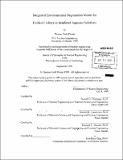| dc.contributor.advisor | Ronald G. Ballinger. | en_US |
| dc.contributor.author | Pleune, Thomas Todd, 1974- | en_US |
| dc.contributor.other | Massachusetts Institute of Technology. Department of Nuclear Engineering. | en_US |
| dc.date.accessioned | 2014-01-23T18:29:52Z | |
| dc.date.available | 2014-01-23T18:29:52Z | |
| dc.date.copyright | 1999 | en_US |
| dc.date.issued | 1999 | en_US |
| dc.identifier.uri | http://hdl.handle.net/1721.1/84224 | |
| dc.description | Thesis (Ph.D.)--Massachusetts Institute of Technology, Dept. of Nuclear Engineering, 1999. | en_US |
| dc.description | Includes bibliographical references. | en_US |
| dc.description.abstract | An integrated model has been developed to evaluate the effect of reactor flux, fluence, and other operating conditions on crack growth rates in austenitic stainless steels in boiling water reactor (BWR) environments. The model evaluates the following in order to account for all factors affecting irradiation assisted stress corrosion cracking. *water chemistry including radiolysis and hydrogen injection *radiation induced segregation of the metal *radiation hardening of the metal *crack tip strain rate of a growing crack *dissolution rate at the crack tip following passive film rupture. The results of each of these models are combined to determine the crack advance rate for the given conditions. Environmentally assisted cracking (EAC) is a phenomenon where a combination of aggressive environment, susceptible material, and significant tensile stress result in accelerated degradation, including stress corrosion cracking (SCC), and hydrogen embrittlement. The EAC model is based on first principles electrochemistry and physical metallurgy. The effect of neutron and gamma radiation dose is included so that irradiation assisted stress corrosion cracking can be studied. By integrating the bulk chemistry with crack tip processes, the crack growth behavior of an aqueous system can be completely characterized. The model integrates chemistry and mechanical behavior to allow the study of EAC in general. | en_US |
| dc.description.abstract | (cont.) EAC phenomena of interest include anodically driven stress corrosion cracking as well as cathodically driven hydrogen embrittlement. The model is able to predict measured data in the literature with good accuracy and precision. It predicts the effects of dose-rate and accumulated dose on stress corrosion cracking in BWRs. This model contributes to the field of crack growth modeling by creating a complete picture including all the major factors effecting crack growth in irradiated systems. | en_US |
| dc.description.statementofresponsibility | by Thomas Todd Pleune. | en_US |
| dc.format.extent | 205 p. | en_US |
| dc.language.iso | eng | en_US |
| dc.publisher | Massachusetts Institute of Technology | en_US |
| dc.relation.requires | Label on CDROM reads: Software installation files and source code for 32-bit PC (Pentium w/Win 95/98, NT 4) | en_US |
| dc.rights | M.I.T. theses are protected by
copyright. They may be viewed from this source for any purpose, but
reproduction or distribution in any format is prohibited without written
permission. See provided URL for inquiries about permission. | en_US |
| dc.rights.uri | http://dspace.mit.edu/handle/1721.1/7582 | en_US |
| dc.subject | Nuclear Engineering. | en_US |
| dc.title | Integrated environmental degradation model for Fe-Ni-Cr alloys in irradiated aqueous solutions | en_US |
| dc.type | Thesis | en_US |
| dc.description.degree | Ph.D. | en_US |
| dc.contributor.department | Massachusetts Institute of Technology. Department of Nuclear Engineering | en_US |
| dc.contributor.department | Massachusetts Institute of Technology. Department of Nuclear Science and Engineering | |
| dc.identifier.oclc | 48759771 | en_US |
